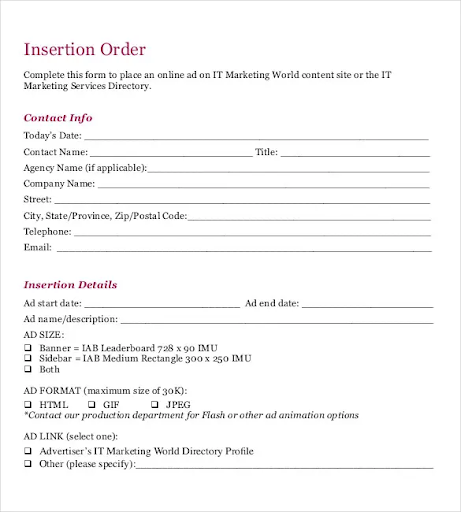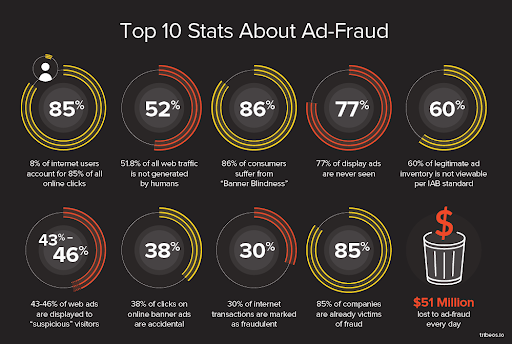The proven all-in-one platform to maximize ad revenue
Protect your ad revenue against invalid traffic and ad fraud

This post was most recently updated on March 6th, 2024
As a publisher, you should be well-versed in the terminology and process of working with insertion orders. After all, they’re one of the most common ways to purchase advertising space.
Insertion orders are a way for both parties involved to have more control over their ad experience. However, what is an insertion order exactly?
This blog post will explain everything you need to know about insertion orders to help you make the most of them.
An insertion order, also known as an IO, is a document that outlines the terms and conditions of an advertising campaign. IOs are commonly used in traditional media, such as print, radio, and television. However, they can also be used in digital media, such as online advertising and email marketing.
IO outlines all of the details of the advertising agreement, including:
Typically, the publisher drafts the insertion order, but the advertiser may also do so. Here’s an example you might use as a reference or model for your work.
This document is essential because it ensures that both parties are on the same page regarding the terms of the agreement.

An insertion order benefits the advertiser and the publisher for several reasons. For the advertiser, it helps ensure that their ad will be placed in a specific location on a site and that the right audience will see it. This is crucial to building awareness about the product, which is one of the fundamentals of SaaS marketing, B2C marketing, and any other type of marketing you can think of.
The insertion orders also ensure that advertisers get the best possible value for their advertising dollars, whether they’re an established entity or a small one still seeking other grants to start a business. Advertisers can track how many people have visited the ad, how long they viewed it, and what actions they took as a result. This data can then be used to help optimize future campaigns.
For the publisher, an insertion order helps ensure they’re being paid for their ad space. It also allows them to track how well each ad performs so they can make adjustments as needed.
Using an IO can also help protect both parties’ interests if something goes wrong with the campaign. For example, if there’s a technical error on the publisher’s end that results in fewer impressions than initially agreed upon, the advertiser may be entitled to a refund or other compensation. This is especially important considering that $51 million is lost to ad fraud daily.

Similarly, if the advertiser fails to pay invoices on time, the publisher may have grounds to terminate the contract. By requiring payment upfront or setting clear milestones for payment throughout the campaign, publishers can safeguard themselves against these types of clients.
Another benefit of using an IO is that it helps ensure both parties are clear on the expectations for the campaign. Independent publishers are likely to have lower ROI than what sponsors expect.
So, the IO should outline the deliverables expected from the publisher, such as the number of impressions or click-throughs and deadlines that need to be met. This clarity can help ensure both parties are satisfied with the campaign results.
Having a written record of the terms that both parties agreed to can help you resolve any disagreements quickly and efficiently.
An insertion order can be a helpful tool for publishers and advertisers when outlining the terms of their relationship. However, there are some drawbacks.
For advertisers, an insertion order is a legally binding document, which means that once it’s signed, both parties are committed to meeting the obligations laid out in the contract. This can be problematic for advertisers if they change their campaign midway through.
For example, if an advertiser wants to add ad units or change the dates their ads will run, they would need the publisher to agree to those changes in writing. This can often be time-consuming, as both parties need to review and sign off on any revisions.
In addition, advertisers may not have as much flexibility when pricing with an IO. The price of each ad unit is typically set in advance, and if an advertiser wants to change it, they would need to negotiate with the publisher. This can be difficult, especially if the campaign is already underway and the publisher is happy with the current pricing.
While an insertion order can provide some stability for publishers, as they know exactly how much revenue they’ll generate from a campaign and when it will start and end, it also means that they could miss out on potential revenue if an advertiser wants to make changes.
For example, if an advertiser wants to extend their campaign or add additional ad units after the IO has been signed, the publisher would need to agree to those changes for them to take effect.
As a publisher, you must understand how to negotiate and execute an IO to protect your interest correctly. When drafting an insertion order, there are best practices to keep in mind:
Following these tips may ensure that the advertisement experience goes as planned for both parties.
An insertion order is a contract between an advertiser and publisher that outlines the specifics of an advertising campaign. Overall, there are many benefits to using an insertion order for your next advertising campaign.
It can help protect advertisers and publishers by providing a written record of the terms and expectations for the campaign. It also outlines what each party is responsible for if something goes wrong.
Want MonetizeMore to implement your Insertion Orders and help you 10X your ad earnings? Let’s talk!

Nico is the founder of Crunch Marketing. The company works with enterprise SaaS clients, helping them scale lead generation globally across EMEA, APAC, and other regions.

With over ten years at the forefront of programmatic advertising, Aleesha Jacob is a renowned Ad-Tech expert, blending innovative strategies with cutting-edge technology. Her insights have reshaped programmatic advertising, leading to groundbreaking campaigns and 10X ROI increases for publishers and global brands. She believes in setting new standards in dynamic ad targeting and optimization.
10X your ad revenue with our award-winning solutions.